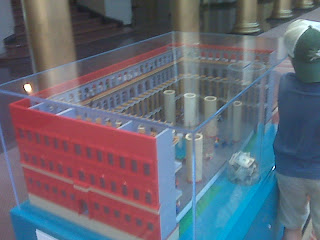I find the admission price for the International Spy Museum a little steep: $18 for adults and $15 for children 12 and under. I've been spoiled by all the free museums in D.C.; These are not unusual admission prices for a museum in any other city. I was able to get two tickets for $9 each, plus a $3.50 fee from the discounted ticket web site Goldstar (www.goldstar.com). Tickets to the Spy Museum on Goldstar are available only for select days. I had to make my purchase a day in advance, but I saved $11.50.
As we waited to board the elevator from the ground level entry area, a statue of Lenin dangled over our heads. A plaque on the wall showed a photo of the same statue being toppled at the collapse of the Soviet Union. Cold war era exhibits dominate the museum, but exhibits from other eras can be found throughout the museum.
From the elevator we were escorted into a small theater to watch a short, interesting, and enjoyable film on espionage and spycraft. From there we were released into a room with many plaques bearing basic details of a cover identity. Another plaque instructed us to remember the details of one the identities. I've been to the Spy Museum a few times, and I've yet to find any other exhibit in the museum that asks me to recall the details of my chosen cover identity.
There are many artifacts of espionage in the museum, such as a chunk of concrete with an embedded listening device from the U.S. embassy in Moscow, and a German enigma machine for decoding orders to troops deployed during World War II. Some exhibits explain the skills and tools of intelligence gathering. Others explain significant or famous incidences.
The museum has a variety of interactive elements. We crawled through duct work to eavesdrop (on the other visitors to the museum?). We sat at computer monitors to analyze satellite imagery of soviet airfield and count and identify aircraft. Some exhibit areas of the museum recreate scenes, such as the Berlin Wall, checkpoint Charlie, and an American dug tunnel underneath the wall.
Finally, the exhibit area exits directly into a gift shop that sells many books, DVDs, gadgets, and toys. From the gift shop is an entrance the full service restaurant Zola, and across the entry area to the museum is the over the counter service Spy Cafe.
The International Spy Museum should interest anyone fascinated by the history of World War II or the Cold War. It is located at 800 F St NW in Washington, D.C. The nearest Metro Station is Gallery Place/Chinatown on the Green and Red Lines. For more information see the museum's website at www.spymuseum.org.
Sent from my Verizon Wireless BlackBerry







